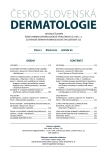-
Medical journals
- Career
Mid-dermal Elastolysis: Case Report
Authors: L. Streitbergová 1; O. Kodet 1,2; M. Kojanová 1; S. Dudková 1; J. Štork 1
Authors‘ workplace: Dermatovenerologická klinika 1. LF UK a VFN přednosta prof. MUDr. Jiří Štork, CSc. 1; Anatomický ústav 1. LF UK přednosta prof. MUDr. Karel Smetana, Jr., DrSc. 2
Published in: Čes-slov Derm, 90, 2015, No. 5, p. 214-217
Category: Case Reports
Overview
Mid-dermal elastolysis (MDE) is a rare skin disease of unknown etiology affecting epecially young women. The role of ultraviolet light is speculated in the pathogenesis of the disease which is histolopathologically characterised by the loss of elastic fibres in the middle dermis and clinically by the wrinked skin surface. Authors report a case of 34-year old women with history of tanning bed exposure presenting with skin lesions on the trunk especially the upper anterior part of the chest histopathologically verified as MDE. After 2 years of follow-up and local therapy with over the counter soya preparations the skin lesions remained stable.
Key words:
mid-dermal elastolysis – wrinkled skin
Sources
1. BANNISTER, M., RUBEL, D., KOSSARD, S. Mid-dermal elastophagocytosis presenting as a persistent reticulate erythema. Australas J. Dermatol., 2001, 42, 1, p. 50–54.
2. COHEN, P. R., TSCHEN, J. A. Linear Lumbar Localized Lysis of Elastic Fibers. J. Clin. Aesthet. Dermatol., 2013, 6, 7, p. 32–39.
3. CRUZ, M. J., BARROS, A., AZEVEDO, F. Generalized mid dermal elastolysis. Dermatol. Reports, 2011, 3, 3, p. 116–117.
4. CUTILLAS, E. E., FERRANDO, F. J., MART, M. E. et al. Reticular variant of mid-dermal elastolysis after insertion of a pacemaker. Clin. Exp. Dermatol., 2010, 35, 5, p. 498–500.
5. EL-KHOURY, J., KURBAN, M., ABBAS, O. et al. Elastophagocytosis: underlying mechanisms and associated cutaneous entities. J. Am. Acad. Dermatol., 2014, 70, 5, p. 934–944.
6. GAMBICHLER, T. Mid-dermal elastolysis revisited. Arch. Dermatol. Res., 2010, 302, 2, 85–93.
7. GAMBICHLER, T., BREUCKMANN, F., KRAUTER, A. et al. Immunohistochemical investigation of mid-dermal elastolysis. Clin. Exp. Dermatol., 2004, 29, p. 192–195.
8. GAMBICHLER, T., STÜCKER, M., KRAUTER, A. et al. Expression of extracellular matrix proteins in reticular variant of mid-dermal elastolysis. J. Eur. Acad. Dermatol. Venereol., 2010, 24, 12, p. 1481–1484.
9. HASHIMOTO, K., TYE, M. J. Upper dermal elastolysis: A comparative study with mid-dermal elastolysis. J. Cutan. Pathol., 1994, 21, 6, p. 533–540.
10. LEYDEN, J., WALLO, W. The mechanism of action and clinical benefits of soy for the treatment of hyperpigmentation. Int. J. Dermatol., 2011, 50, 4, p. 470–477.
11. MARTÍNEZ-ESCALA, M., ROZAS, E., PUJOL, R. M. et al. Mid-dermal Elastolysis: Another Dermatological Clue to Autoimmunity? Acta Derm. Venereol., 2012, 92, 4, p. 434–435.
12. PATROI, I., ANNESSI, G., GIROLOMONI, G. Mid-dermal elastolysis: a clinical, histologic, and immunohistochemical study of 11 patients. J. Am. Acad. Dermatol., 2003, 48, p. 846–851.
13. POSADA, C., NO, N., TORRE, C. et al. Reticular variant of mid-dermal elastolysis. Australas J. Dermatol., 2013, 54, 1, p. 69–71.
14. SCOLA, N., GOULIOUMIS, A., GAMBICHLER, T. Non-invasive imaging of mid-dermal elastolysis. Clin. Exp. Dermatol., 2011, 36, 2, p. 155–160.
15. SEIBERG, M. Non-denatured Soybean Extracts in Skin Care: Multiple Anti-Aging Effects. Soybean – Biochemistry, Chemistry and Physiology, 2011, (CC BY-NC-SA 3.0 license), p. 120–136.
16. SHELLEY, W. B., WOOD, M. G. Wrinkles due to idiopathic loss of mid-dermal elastic tissue. Br. J. Dermatol., 1977, 97, 4, p. 441–445.
17. SUDA, T., HARA, H., YOSHITAKE, M. et al. Immunohistochemical investigation of mid-dermal elastolysis with a history of erythema. Am. J. Dermatopathol., 2008, 30, p. 477–480.
18. TAJIMA, S., INAZUMI, T., KAJIYA, H. et al. Elastin metabolism in skin Wbroblasts explanted from a patient with mid-dermal elastolysis. Br. J. Dermatol., 1999, 140, p. 752–754.
19. UYAR, B., SIVRIKOZ, O. N., OZDEMIR, U. et al. Histological investigation of the effect of soybean (Glycine max) extracts on the collagen layer and estrogen receptors in the skin of female rats. Clinics (Sao Paulo), 2014, 69, 12, p. 854–861.
20. ZHAO, R., BRUNING, E., ROSSETTI, D. et al. Extracts from Glycine max (soybean) induce elastin synthesis and inhibit elastase activity. Exp. Dermatol., 2009, 18, 10, p. 883–886.
Labels
Dermatology & STDs Paediatric dermatology & STDs
Article was published inCzech-Slovak Dermatology

2015 Issue 5-
All articles in this issue
- Relation between Sensitization to Respiratory Allergens and Bronchial Asthma, Allergic Rhinitis and Further Parameters in Patients with Atopic Eczema
-
Současné praktické postupy pro vyšetřování a léčbu chronické urtikárie
Aktualizovaný přehled a interpretace doporučených postupů pro praxi - Mid-dermal Elastolysis: Case Report
- Itchy Rash in Pregnancy
- Forthcoming events
- Editorial
- Diffuse Hair Loss in Women in Clinical Practice
- Czech-Slovak Dermatology
- Journal archive
- Current issue
- Online only
- About the journal
Most read in this issue- Diffuse Hair Loss in Women in Clinical Practice
-
Současné praktické postupy pro vyšetřování a léčbu chronické urtikárie
Aktualizovaný přehled a interpretace doporučených postupů pro praxi - Itchy Rash in Pregnancy
- Mid-dermal Elastolysis: Case Report
Login#ADS_BOTTOM_SCRIPTS#Forgotten passwordEnter the email address that you registered with. We will send you instructions on how to set a new password.
- Career

